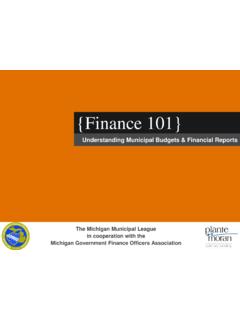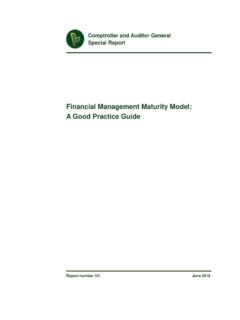Transcription of Appendix – Definitions of Account Codes - Michigan
1 Appendix Definitions of Account Codes December 2012 1 Table of Contents CATEGORY PAGE NUMBER INTRODUCTION 2 CODING STRUCTURE 3 FUNDS AND TRANSACTION Codes 4 ASSETS 5 FIXED ASSETS 7 budgeting ACCOUNTS AND OTHER DEBITS 9 LIABILITIES 10 budgeting ACCOUNTS AND OTHER CREDITS 13 RESERVES AND FUND BALANCE 14 REVENUES - MAJOR CLASS 15 REVENUES - SUFFIX 22 EXPENDITURES - FUNCTION 24 EXPENDITURES - OBJECT/ACTIVITY 33 EXPENDITURES - PROGRAM 47 EXPENDITURES - GRANT code 49 Appendix Definitions of Account Codes December 2012 2 INTRODUCTION The purpose of this section is to provide the reader with an overview of the required coding structure; the graphic display and Definitions which follow should be used for that purpose.
2 The coding structure is consistent with Financial Accounting for Local and State School Systems published by the National Center for Education Statistics, 2009. Standard coding found in this section is necessary to satisfy state and federal reporting requirements. Each district should review local needs before additional elements of the coding structure are added. The accounting system designed should accommodate the planning, budgeting , evaluating, and analysis functions of the system and should be cross-referenced to other information files of that system. Dimension - Block of related digits. Fund - An independent fiscal and accounting entity, preferably with a self-balancing set of accounts, with its own assets, liabilities, resources, and fund balances which are segregated for the purpose of carrying on specific activities in accordance with special regulations, restrictions, or limitations (two positions).
3 Edited field in the Financial Information Database (FID) Transaction code - A code used to identify whether an accounting entry is balance sheet, revenue, or expenditure (one position). Used internally in district accounting systems. Not reported to the FID as a separate field. The transaction code is used to determine which file (revenue, expenditure, or balance sheet) the record is to be uploaded for FID submission. Major Class - The basic Account identifier for recording transactions involving assets, liabilities, fund balance and revenues (three positions). Edited field in the FID. Suffix - The code used to further define/distinguish between revenue sources (four positions).
4 Edited field in the FID. Edited for revenue records, but not balance sheet. Function -The basic Account identifier for expenditures. It describes the activity for which a service or material is acquired. The basic functional categories operated by most districts are instruction, pupil support, instructional staff support, general administration, business services, operations and maintenance, transportation, central services, community services, and facilities acquisition. Edited field in FID. Object - The code used to describe the service or commodity obtained as the result of a specific expenditure. The broad object code categories include salaries, benefits, purchased services, supplies/materials, and capital outlay.
5 Edited to the 2nd position in FID. Program - The code used to describe a plan of activities and procedures designed to accomplish predetermined objective or set of allied objectives (three positions). Edited field in the FID. Grant code - The code used to identify various grant programs/funding source (four positions). Fourth position may be used at district s discretion. This is a required field for reporting all restricted grant related expenditures. We recommend using it on all corresponding restricted grant revenue records as a good financial management practice. Some grant offices may require that districts report information in this field on both FID revenue and expenditure records as a condition for receiving a particular grant.
6 Facility/School - The state assigned code used to designate a district building or administrative unit. (five positions). Edited field in the FID. Other - A dimension available to further define a school district's activities; , subject matter, special cost center, etc. (four positions). Appendix Definitions of Account Codes December 2012 3 CODING STRUCTURE BALANCE SHEET Fund Transaction code Major Class Suffix Not Used X X X X X X X X X X XX X X - X X X X - X X X X - X X X X REVENUES Fund Transaction Major Class Suffix Grant Other X X X X X X X X X X X X X X X X X X X X XX- X X X X EXPENDITURES Fund Transaction Function Object Program Grant Facility /School Other X X X X X X X X X X X X X X X X X X X X X X X X X X Appendix Definitions of Account Codes Fund Codes December 2015 4 Account code Fund Type Fund Name 11 General
7 Fund (1) General Fund 21 Special Revenue (2) Athletic Fund 22 Special Revenue (2) * Special Education Fund 23 Special Revenue (2) Community Service Fund 24 Special Revenue (2) Bookstore Fund 25 Special Revenue (2) Food Service Fund 26 Special Revenue (2) *Vocational Education Fund 27 Special Revenue (2) Cooperative Activities Fund 28 Special Revenue (2) Private Purpose Trust Fund 31 - 39 Debt Service Funds (3) Debt Service Funds 41 - 49 Capital Projects Fund (4) Capital Projects Funds 51 - 59 Trust Funds (5) Trust Funds 61 - 69 Agency Funds (6) Agency Funds 71 79 Enterprise (7) Enterprise 81 89 Internal Service (8) Internal Service 91 99 District Wide Reporting (9) District Wide Reporting 91 District Wide Reporting (9) Capital Asset Accounts 92 District Wide Reporting (9) Long Term Liability Accounts * These funds may only be used by intermediate school district and center programs.
8 See Section II for a description of fund types. TRANSACTION Codes Account code Transaction 0 Revenue Accounts 1 Expenditure Accounts 2 Balance Sheet Accounts Appendix Definitions of Account Codes Balance Sheet Major Class Codes December 2010 5 Major Class code Allowable Funds Account Name/Description 100 Cash Accounts 101 11, 2x, 3x, 4x, 5x, 6x, 7x, 8x Cash - Currency, coin, checks, postal and express money orders, and banker's drafts on hand, or on deposit, with an official or agent designated as custodian of cash and bank deposits. 102 11, 2x, 3x, 4x, 5x, 7x, 8x Petty Cash - A sum of money set aside for the purpose of paying small obligations for which the issuance of a formal voucher and check would be too expensive and time consuming.
9 103 11, 2x, 3x, 4x, 5x, 7x, 8x Cash Change Funds - A sum of money set aside for the purpose of providing cash register change. 110 Taxes Receivable 111 11, 2x, 3x, 4x, 7x Taxes Receivable - The uncollected portion of taxes that a school system or governmental unit has levied and which has become due, including any interest or penalties which may be accrued. Subsidiary accounts may be maintained on the basis of tax roll year and/or current and delinquent taxes. 112 11, 2x, 3x, 4x, 7x Allowance for Uncollectible Taxes (Credit) The portion of taxes receivable estimated not to be collected. The Account is shown on the balance sheet as a deduction from the taxes receivable Account to arrive at net taxes receivable.
10 120 Accounts Receivable 121 11, 2x, 3x, 4x, 5x, 6x, 7x, 8x Accounts Receivable - Amounts owing an open Account from private persons, firms, or corporations for goods and services furnished by a school system (but not including amounts due from other funds or from other governmental units). Although taxes receivable are covered by this term, they should be recorded and reported separately in the Taxes Receivable accounts. 130 Due From Other Funds 131 11, 2x, 3x, 4x, 5x, 6x, 7x, 8x Due From Other Funds - An asset Account used to indicate amounts owed to a particular fund by another fund in the same school system for goods sold or services rendered.














